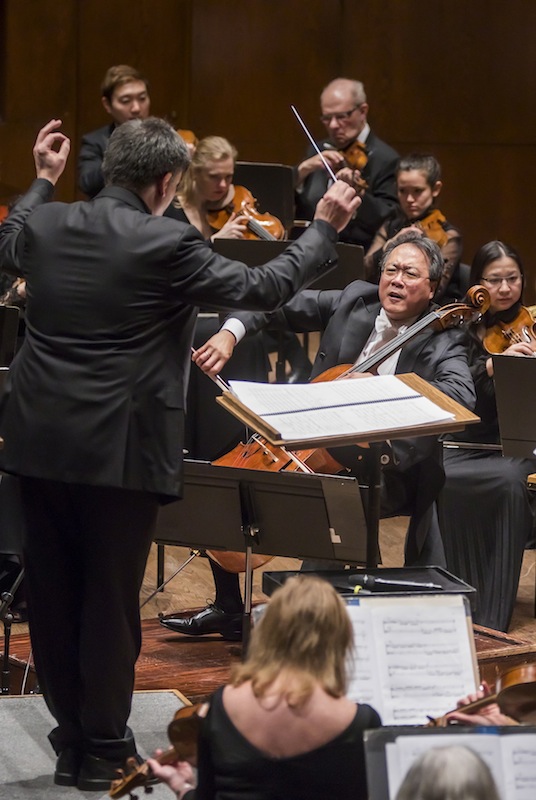Salonen’s new Cello Concerto a mixed bag of cool from Ma, Philharmonic

Yo-Yo Ma performs Esa-Pekka Salonen’s Cello Concerto with Alan Gilbert and the New York Philharmonic Wednesday night at David Geffen Hall. Photo: Chris Lee.
Two major musical planets aligned Wednesday night in David Geffen Hall, but the result was something less than astrologers might have predicted.
The prospect of Esa-Pekka Salonen, composer of dazzling concertos for violinist Leila Josefowicz and pianist Yefim Bronfman, taking cellist Yo-Yo Ma as his latest concerto muse was mouth-watering, to say the least. The work’s world premiere last week, with Ma and the Chicago Symphony Orchestra led by the composer, was warmly received.
It was perhaps to deal with such expectations that conductor Gilbert invited the composer onstage before the performance to talk about what he was trying to do in the piece. In an off-the-cuff summary of his long program note, Salonen described the three-movement concerto as “one continuous zoom”–starting amid “chaos” far out in space, passing a theme trailing fragments of itself “like the tail of a comet,” focusing closer and closer until, by the third movement, the music was about a single person “for whom words are not enough, so he is gesticulating.” Finally “the individual bursts out” with a single note, the extremely high B flat that ends the piece.
This seemed perilously close to admitting that the composer wouldn’t “let Ma be Ma” until the concerto’s last page. But Salonen was also quoted in the program book as saying, “A true virtuoso can also capture the beauty and expression in the quietest moments, to fill near-stasis with life through a musician’s imagination and ability to communicate.” This fairly describes what the cellist worked hard to do at many points in the piece, particularly in the second movement, which not only came near stasis, but sometimes fell right in.
At the same time, Ma understood the Sibelius-like Scandinavian reserve that is a feature of even Salonen’s most spectacular music. Spinning out his open-ended “comet” melody in the first movement, the cellist played with full tone and plenty of vibrato but also a kind of interstellar calm that was worlds away from the hair-shaking passion of, say, Dvořák or Elgar.
Whatever his objectives in a piece, the conductor-composer Salonen can be counted on to write for orchestra with exceptional imagination. This concerto continually surprised and delighted the ear with fresh sounds, from the chugging, twinkling orchestral “chaos” of the opening pages (reminiscent of the concert’s opening piece, John Adams’s The Chairman Dances) to the third movement’s cello-conga duet between Ma and the Philharmonic’s principal percussionist Christopher S. Lamb.
The first movement’s outer-space music floated in a vibraphone-tinted, Scriabin-like ecstasy, its steady pace unruffled by sudden flutterings of woodwinds or agitated passages in the solo cello. Orchestral textures ranged from the most luscious tutti to a gossamer tissue of pianissimo high violins.
The second movement began boldly in the brass, but soon dwindled to a roomful of silences that made Bartók’s flimsiest “night music” sound like rush hour at Grand Central. The soloist and individual players in the orchestra focused intensely on wringing musical meaning out of scarcity, with the emptiness partly filled by looped echoes of Ma’s live playing, until glissando cries began to gather in a kind of rainforest nocturne and deep chords welled up to swallow the fluttering cello.
In the third movement, with percussionist Lamb urging him on from an array of congas and bongos at the front of the stage, Ma went from speedy to emphatic to dancing, and from scales to rapid string-crossing to a dazzling mix of right- and left-hand pizzicato with bowed notes. If the meaning of all this “gesticulating” wasn’t immediately clear, it certainly was fascinating to watch. Novel orchestral scoring from tender to bombastic completed the picture, and the cello’s crazy-high final B flat touched off a quite respectable ovation.
As mentioned, the concert opened with Adams’s sly, silky study for his opera Nixon in China, amazingly the first performance of this 1985 modern repertoire staple on a Philharmonic subscription program. Gilbert and his players gave this “foxtrot for orchestra” a certain New York subway momentum, at least until some Gershwinesque swooning strings conjured up the young Mao Tse-Tung whirling his movie-star girlfriend around the dance floor.
Although tautly executed with a fine balance of orchestral colors, the first two movements of Berlioz’s Symphonie fantastique suffered from a kind of Salonen-like objectivity that left a lot of tender and passionate emotions on the table. The second movement in particular was hardly waltz-like at all, its 3/4 meter either metronomic or rushed. The ”near-stasis” of the pastoral third movement, however, was well served by a steady forward motion and a series of rich-toned wind solos.
The performance hit its stride spectacularly in the feverish final two movements, beginning with the ominous rumble that opened the “March to the Scaffold” and blossoming into a brass tune that never sounded more grotesquely cheerful. All of Berlioz’s bizarre orchestral effects scored direct hits (without sounding like “effects”) in this supremely scary performance.
The “Dream of a Witches’ Sabbath” finale, with its quick-cutting scenario, is harder than the march to hold together, but Gilbert and his players did so with a steady, compelling tempo and exciting stretto passages that kept the music tumbling ahead, one vividly rendered scene after another, to the final brassy conflagration.
The program will be repeated 7:30 p.m. Thursday and 8 p.m. Friday and Saturday. nyphil.org; 212-875-5656.






